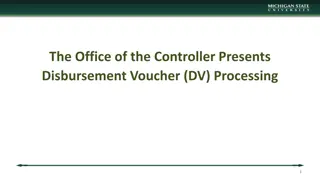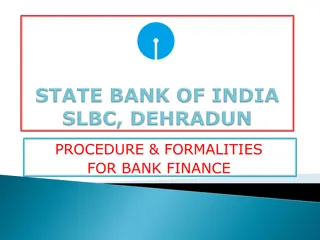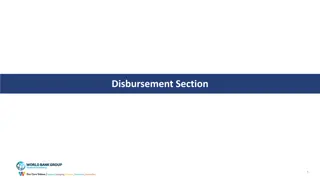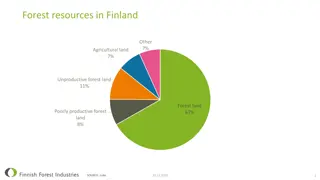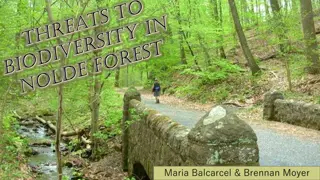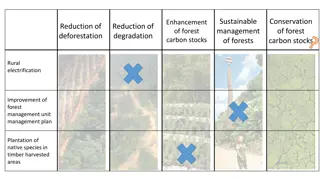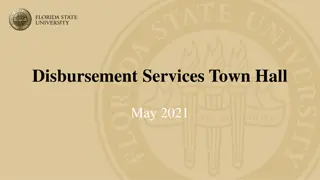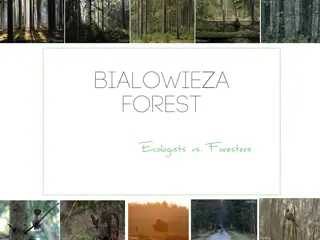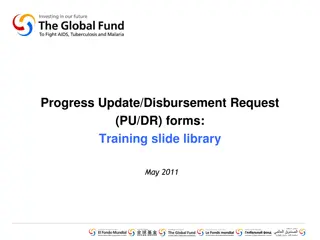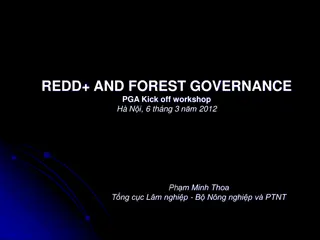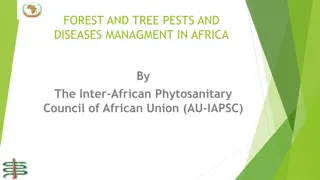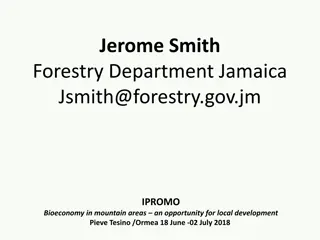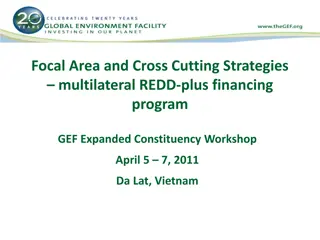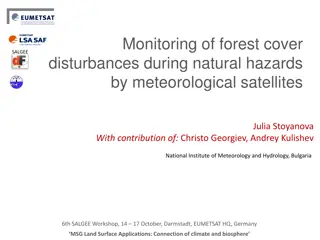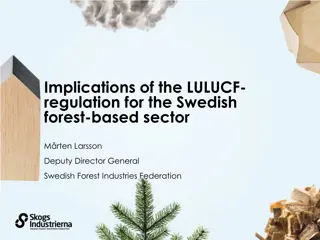Policy Disbursement Methods and Challenges in Forest Protection Programs
This presentation provides an overview of policy disbursement methods, the process of disbursement, difficulties, challenges, and the way forward in forest protection programs. It discusses key messages, initial impacts of the policy, aligning PFES with REDD+, and benefit sharing mechanisms.
Download Presentation

Please find below an Image/Link to download the presentation.
The content on the website is provided AS IS for your information and personal use only. It may not be sold, licensed, or shared on other websites without obtaining consent from the author.If you encounter any issues during the download, it is possible that the publisher has removed the file from their server.
You are allowed to download the files provided on this website for personal or commercial use, subject to the condition that they are used lawfully. All files are the property of their respective owners.
The content on the website is provided AS IS for your information and personal use only. It may not be sold, licensed, or shared on other websites without obtaining consent from the author.
E N D
Presentation Transcript
Contents of Presentation OVERVIEW ON POLICY DISBURSEMENT METHODS PROCESS OF DISBURSEMENT DIFFICULTIES, CHALLENGES THE WAY FORWARD KEY MESSAGE
OVERVIEW ON POLICY 24/09/2010 Decree 99 on the implementation of PFES policy nationwide 10/04/2008 Decision 380 on the PFES piloting in Lam Dong and Son La provinces 14/01/2008 Decree 05 on the establishment of FPDFs
Initial impacts of the policy Established 33 provincial FPDFs; Some provinces established a system of Funds at district level (Son La) and at commune level (Quang Tri) Increase contribution of forestry sector in the economy (collected more than 2,300 billion dong) INSTITUTION ECONOMY SOCIETY ENVIRONMENT Contribute to improve livelihoods, poverty reduction for people rely on forests Contribute to reduce violation cases; increase forest area and coverage
Initial impacts of the policy PFES policy addressed clearly opinions of market economy orientation, sustainable development, utilization of multi-purpose forest and it would be a policy with clear and transparent benefit sharing mechanism.
Aligning PFES with REDD+ ECONOMY PFES SUSTAINA -BLE FOREST DEVELOP- MENT FOREST PROTECTION AND DEVELOPMENT FUND OTHER SOURCES SOCIETY REDD+ ENVIRONMENT RESOUCES MEANS OBJECTIVES RESULT
Benefit sharing mechanism CENTRAL FUND (VNFF) (Deduct 0.5% operation cost) FES users 100% 99,5% 100% PROVINCIAL FUND (PFPDF) (Deduct 10 % operation cost, 5% contingency) FES suppliers (forest owner, organization, household, individuals, communities) 85% Self-protection FOREST OWNER IS ORGANIZATION (Deduct 10% management cost) FOREST OWNER IS HOUSEHOLDS, INDIVIDUALS, COMMUNITIES (Can use 100% received payment) Contract for household, individuals, communities
DISBURSEMENT METHODS DISBURSE TO EACH HOUSEHOLD, INDIVIDUAL DISBURSE TO ORGANIZATION DISBURSE TO HOUSEHOLD GROUP, COMMUNITIES DISBURSEMENT METHODS
Advantages of payment for household group Quick disbursement progress; Reduce management focal point; Reduce workload (dossier, paper); Reduce transaction cost; Increase activeness, right to decide for community; Suitable to the customs of the local people, ethnic minorities; Promote the spirit of cooperation and mutual support of the community; Help community with livelihood development.
Process of developing payment mechanism in group 1st meeting with people Draft payment mechanism Documented mechanism 2nd meeting Issue mechanism Group meeting Disseminate policy; Present ideas; Listen to contribution ideas Draft mechanism; Draft list of groups; Consult leader. Introduce draft of mechanism; Introduce list of groups; Listen to comments Finalize draft of mechanism; Submit authorized levels for issuance. Introduce mechanism; Announce allocated payment; Assign tasks; Listen to feedback comments Documentation & printing in form of brochures, leaflets; Circulate to each household to supervise the implementation
The involvement of people within household groups Monitor activities; Supervise activities; Evaluate activities; Response and propose changes Know what they have; Know what they need; Know policy of State. People check People know People do People discuss Contribute efforts Involve in implementing group s tasks Determine objectives; Planning; Agree solutions.
DISBURSEMENT PROCESS AND PROCEDURES Principles and conditions of disbursement; Basis to determine PFES amount to pay for forest owners; Process and procedures of disbursement.
Principles & conditions of disbursement Only disburse to forest area supplying FES; Forest owners, households, individuals contracted for forest protection must have enough document to prove their ownership or right to use or being assigned to use the forest area supplying PFES; Forest owners, households, individuals contracted for forest protection must have long term and stable commitment/or contracts for forest protection; Disbursement must be based on the plan approved by authorized agencies. PFES amount received by forest owners must be proportional to (depends on the increase or decrease) the quantity and quality of forest supplying FES.
Basis of disbursement to forest owners Quantity (forest area) of supplying services; Quality of forest (identified through coefficient K); Unit price of payment/ha (PFES source collected from service users/total of supplying forest area).
Calculation of pfes amount for forest owners Total FES amount received by forest owners Average PFES unit price paid per ha of forest (VND/ha) Forest area allocated for contracted for protection (ha) The adjustment coefficient of payment rates (K) = * * K1 - Status and forest volume: 1.00 - rich forest; 0.95 - average forest; 0.90 - poor and restoration forest. K = K1* K2* K3* K4 K2 Utilization purposes: 1.00 - special use forests; 0.95 - restoration forest and 0.90 - plantation forest. K3 Origin of forest establishment: 1.00 natural forest; 0.90 plantation forest. K4 Difficulty levels for forest protection: 1.00 - very difficult; 0.95 - difficult; 0.90 - less difficult.
Disbursement process and procedures Identify subjects of using FES (hydropower plants, water supply and tourism facilities); Sign trust contract and receive PFES money; Identify subjects of supplying FES (forest area boundary, forest status for each forest owner/household, individuals contracted for forest protection); Organize the signing committment/contract to allocate for forest protection; Advance for forest owners/households, individuals; Implement activities of forest protection; Acceptance and public acceptance results; Final settlement of PFES money.
DIFFICULTIES AND CHALLENGES Slow disbursement progress; low disbursement rate; Lack of resources (budget, qualified personnel) to identify forest owner; Forest status always change through years (compared with actual records, documents, maps); Technical guidance (GPS, GIS, Mapinfor ) is still not adequate and specific; Coefficient K has not been applied widely in provinces; Do not have finalized M&E system.
THE WAY FORWARD Promote cooperation to enlist the support of relevant stakeholders on finance and technique; Strengthen policy propaganda and dissemination; Issue technical guidelines; organize training courses; Establish database for the information management and sharing on PFES; Develop an M&E system (regulations, M&E mechanism).
KEY MESSAGE To implement PFES successfully, it is needed to promote the communication and dissemination of policy through different information channels in order to raise awareness, create the consensus of the whole society; especially FES suppliers and users; PFES policy is new and needed the interest and involvement of all authorized levels and cooperation on both finance and technical support of relevant stakeholders.



